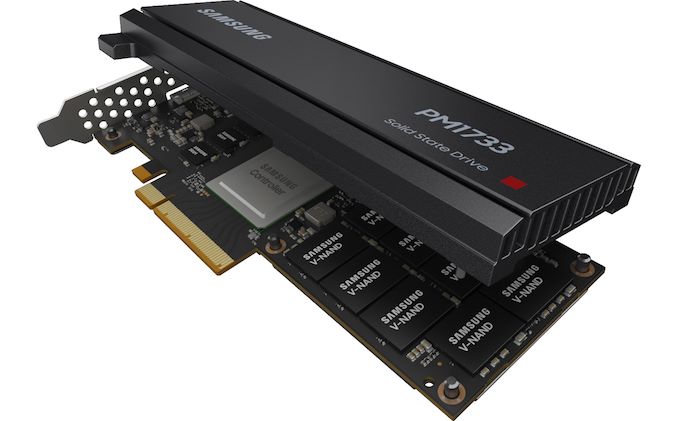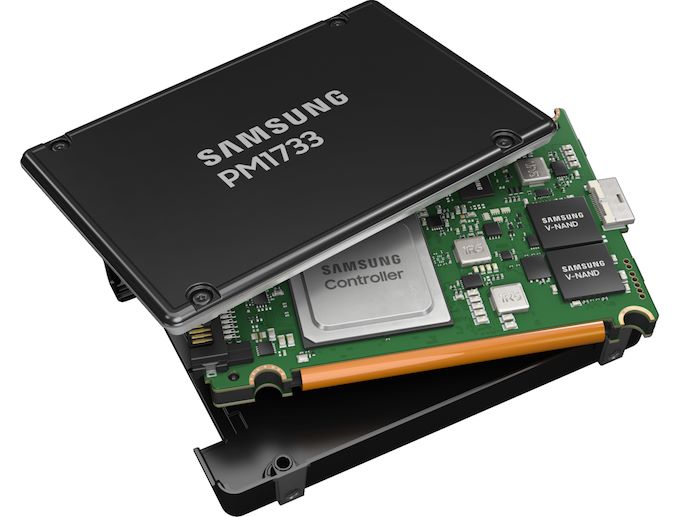Samsung Preps PM1733 PCIe 4.0 Enterprise SSDs For AMD's "Rome" EPYC Processors
by Anton Shilov on August 9, 2019 10:00 AM EST
With the launch of AMD's new second generation "Rome" EPYC processors, AMD's numerous hardware partners have been lining up to announce their own wares built around the new processors. And this doesn't just go for OEMs and integrators, but it also extends to component suppliers who have been eagerly awaiting the first x86 server processor with PCIe 4.0 support. To that end, yesterday Samsung sent out an announcement confirming that their previously announced PM1733 enterprise SSD supports AMD's new processors, and that just in time for inclusion in Rome systems, they'll be shipping this quarter.
Samsung first announced the PM1733 last fall, as part of its general SSD roadmap update for the then-forthcoming year. The PM1733 is the successor to their PM1723b enterprise SSD, and is designed to take advantage of the bandwidth advances provided by PCIe 4.0. Based on the company’s proprietary controller and paired with 512 Gb 5th Generation V-NAND memory chips, the drive family is rated for read speeds of up to 8 GB/second.
Interestingly, Samsung is offering both PCIe 4.0 x4 and x8 versions of the SSDs, with the U.2 versions using a x4 interface while the alf-length half-height (HHHL) card versions will use x8. The U.2 drives with dual-port capability will offer capacities of up to 30.72 TB, whereas the HHHL cards will carry up to 15.36 TB of useful V-NAND flash.
Overall, Samsung's focus on the drive in terms of specifications is on the drive's read performance rather than its write performance. Along with its 8 GB/sec rated sequential read speed, Samsung says the PM1733 can handle random reads of up to 1500K IOPS, which would make the PM1733 among the fastest drives announced so far.
Samsung will start shipments of its PM1733 SSDs this quarter. Among x86 platforms, the PCIe 4.0 capabilities of the drives will only be available on AMD EPYC 7002 and AMD Ryzen 3000 platforms, but the devices will also work with current PCIe 3.0 platforms from Intel and AMD. The manufacturer has not disclosed prices of the new PM1733 SSDs so far.
Related Reading:
- Samsung 30.72 TB SSDs: Mass Production of PM1643 Begins
- Samsung Launches Broad Range Of Datacenter SSDs
- Samsung Launches Energy-Efficient PM883 SSD with SATA 3.3, LPDDR4
- Samsung At Flash Memory Summit: 96-Layer V-NAND, MLC Z-NAND, New Interfaces
- Samsung Unveils 6th Generation V-NAND Memory with Up to 136 Layers
- Samsung at Flash Memory Summit: 64-layer V-NAND, Bigger SSDs, Z-SSD
Source: Samsung











44 Comments
View All Comments
name99 - Friday, August 9, 2019 - link
If you don’t care about waiting, them why do you care about super fast SSDs? A good old HD does everything an SSD does...And why are WiFi or Internet speeds relevant? Honestly, as soon as you mention that, you disqualify yourself as not understanding anything about what people like me are trying to achieve.
You seem to live in a bubble of “everyone is just like me”. Not true.
- I have multiple computers
- They are connected by ethernet
- Transferring large files (say 1GB or larger) imposes a noticeable wait. Is it unbearable? No. But why wait if I can avoid it?
GreenReaper - Saturday, August 10, 2019 - link
Could get pairs of cards to link them together over a private subnet. Not ideal, but might be faster than waiting for a switch to come.name99 - Sunday, August 11, 2019 - link
Once again that misses the point of HOME! (And that point-to-point becomes ever less practical once you have 3+ machines...)Yes, many things are possible --- and if I wanted to do crazy stunts I could just buy an industrial switch.
The point of HOME kit is that it is small, it is unobtrusive, it is low-hassle!
Kevin G - Sunday, August 11, 2019 - link
Uncompressed or lightly compressed, low latency video transport do like 10 Gbit bandwidth. Think of the networking switch becoming a video matrix router. The entire professional AV space is awaiting this to happen but right now it is suffering from market fragmentation due to too many vendors attempting to lock users in. For one example, see this link for reference: https://news.zeevee.com/blog/zyper4k-hdmi-moduleThe one good thing is that if the previous installation has been wired up correctly for 4K HDbaseT, then the cabling can be reused for 10 Gbit networking. These types of installs are common enough in areas like California where spending several grand on a setup can increase the resale of the home by a factor of 5x from the initial investment (ie spend $10K on this type of gear and it can add $50K to the resale value).
Also 802.11ax is going to enable greater than 1 Gbit speeds in the real world. The company I work for has already transitioned over to CAT6A STP or CAT7 for new construction in anticipation of movingly directly to 802.11ax. Still looking at retrofitting existing installations with 2.5 Gbit or 5 Gbit links over existing cabling with new switches.
The other big driver for new cabling isn't 10 Gbit but being able to fully support the 802.3bt standard for up to 100W of power. Professional audio over a network has been a thing for well over a decade now and 802.3bt enables one last thing for this market: network based speakers. I've seen an inquiry about new corporate construction if it was possible to only use CAT6A STP everything. Outside of a few fiber drops for the network backbone, the answer is actually yes as data, video, audio, and even lighting can be consolidated to a common IP system.
jhh - Friday, August 9, 2019 - link
I think WiFi 6 is likely to change this. TP-Link's pre-standard WiFi 6 come with a 2.5 Gbps port. I'm sure they see the market for selling switches which connect to that, but the chip vendors need a reasonably prices option before the switch vendors can sell it. Then, the home networking providers (Cable/DSL/5G) need to provide something better than 1G without depending on link aggregation.DanNeely - Friday, August 9, 2019 - link
The prices on the 2 router's you're linking to do make sense once you look at the more detailed features.The $399 4+1 port one is 10Gb on all 5 ports. The $249 8+2 port one has 4x1gb, 2x1/2.5, and 2x1/2.5/5gb ports; 2x10gb (one SFP). It's cheaper because it only has a single 10gb RJ-45 port.
10gb is much harder (read needs more expensive electronics) on RJ-45 than on SFP; 2.5/5gb are as much about being easier on the router/card makers as they are about reusing 100m runs of older cable.
name99 - Friday, August 9, 2019 - link
The larger point is not the exact details of the switches, it’s that these are about the best available. And they SUCK for home use.I’m not demanding 10G everywhere; i’d be happy with a nice little 5 port 2.5G box. This is home; I don’t need gimmicks like a single 10G port connecting upstairs with downstairs. But there is NOTHING available like that.
chx1975 - Friday, August 9, 2019 - link
Trendnet is not only one with 2.5gbps, Club 3D was the first to market. Trendnet is easier to get in the USA, Club 3D in the EU. QNAP has an 5GbE product and that's about it. Switches are hard to get indeed -- the cheapest transciever is the Mikrotik S+RJ10 which is 51 USD so even if you get a cheap used SFP+ heavy enterprise switch from eBay, you will pay at least 51 USD per port. Netgear has a few switches with 2.5 and 5 GbE ports but they are 200 USD+. All in all the NBASE-T premise of cheap sub-10GbE Ethernet have not been delivered (yet?).EmperorDeslok - Friday, August 9, 2019 - link
There's lots of inexpensive 10G gear if don't mind going to fiber.Miktorik has the CRS305( https://amzn.to/31s9RCS ) and CRS309( https://amzn.to/2KqtYvD ) which are 4 and 8 10gig ports which with a cheap connectx 3 card(about 40 on ebay) and a direct attach cable give you 10gig cheap and easy.
Mikrotik even has the RB4011iGS+5HacQ2HnD-IN ( https://amzn.to/2KCyPZA ) which is a wireless router with a single 10gig port, a great option if you have a nas or something you want to link to the rest of the network.
Kevin G - Sunday, August 11, 2019 - link
I would disagree with that. 10 Gbit off of 1x PCIe 4.0 is ideal of the embedded market which is sensitive to thinks like board cost etc. Even outside of the embedded market, it would enable on board LAN to easily move to PCIe 4.0 and replace the 1 Gbit links currently on a 1x PCIe 1.0/2.0/3.0 connection.Also of note is that with AMD's Rome launch, they increased the number of PCIe lanes per socket. There is an extra 1x lane which OEMs are now using for BMC management which could now be on a 10 Gbit LAN connection. This has utility when using VNC to get into a system running a GUI.